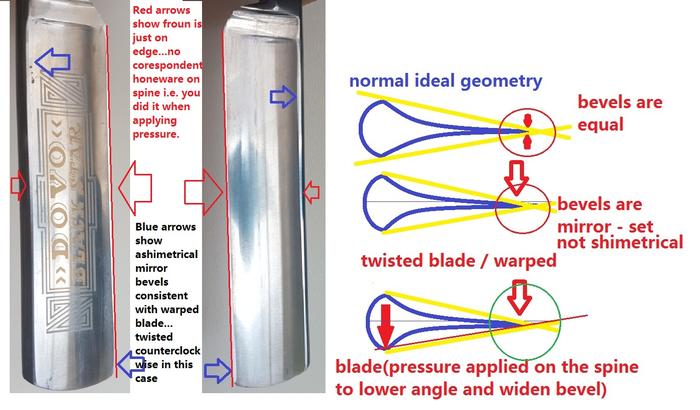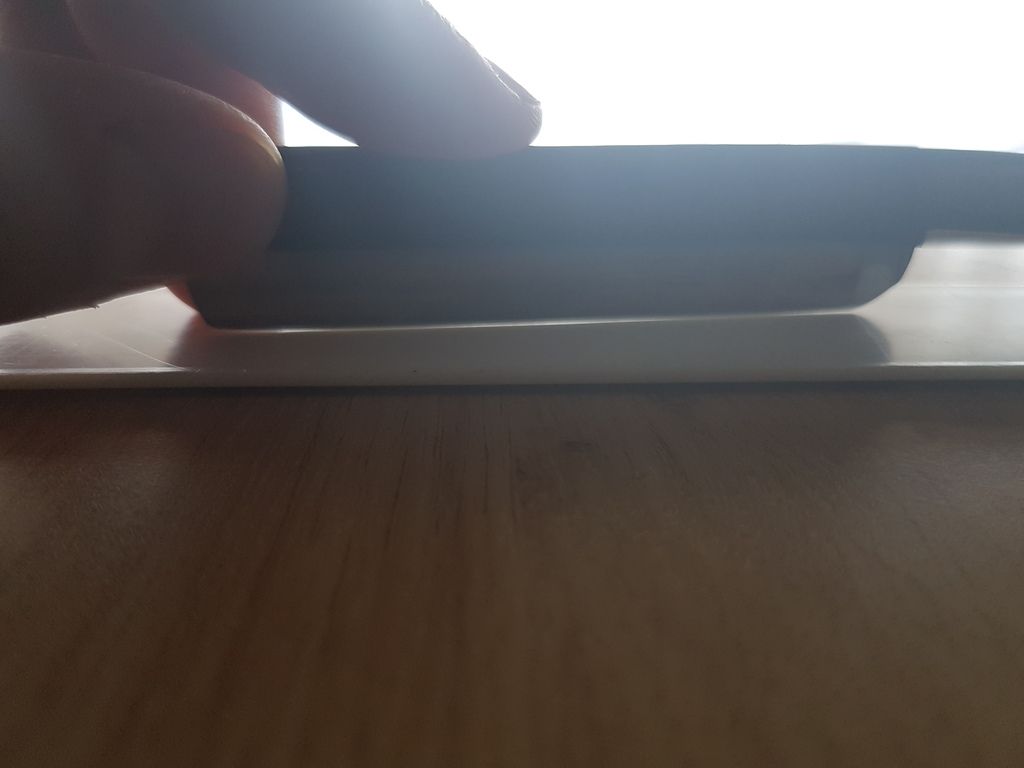Results 1 to 10 of 80
Hybrid View
-
07-31-2017, 07:50 AM #1Member

- Join Date
- May 2011
- Location
- Belgium, Antwerp
- Posts
- 68
Thanked: 6 Bevel setting issue in the middle
Bevel setting issue in the middle
Hi guys,
I'm trying to set a good bevel with a shapton gs 1K. (And am a beginner ...)
So I've got 3 learning blades. One, I was able to hone, set a good bevel, and got it shaving quite "OK".
The other I'm trying out now is something else, It's actually my first razor, a Dovo, which I got year ago, and did try some honing on with a Coticule in the past. It didn't shave well anymore so ended up in the closet ...
Meanwhile I picked up a shapton GS progression and wanted to bring it back.
So, after doing the circle method, followed by straight strokes and x strokes. Not quite counting but watching the water, first I notice that one side was undercutting, the other side not in the middle.
The after doing the TNT I got the confirmation that in the middle something was off.
After doing the sharpie test it is clear that one side of the blade, at that spot I felt with the TNT, is not touching the hone.
What I tried so far was putting 1 finger on that spot and guided the blade doing straight strokes.
Every 5 strokes it finished with x strokes (without finger) and looked and felt at the edge.
Nothing changes.... so here I am wondering
PS: I'm using 1 layer of tape
-
07-31-2017, 08:23 AM #2

Sounds like you may have a slightly bent spine, a frequent occurrence. To rectify this, I would suggest using a rolling X-stroke rather than applying a finger of the off-hand in selected places (which may risk to compound the problem). By using a rolling X-stroke, one is applying pressure from the shank more on a point-by-point basis, from the heel to the middle to the toe by the end of the stroke. In any case, adding tape seems like a good course of action, as it will protect the spine from needless damage during experimentation and add a very mild flattening effect to the bent spine, if that indeed is the case here.
Striving to be brief, I become obscure. --Horace
-
The Following User Says Thank You to Brontosaurus For This Useful Post:
Mikali (08-07-2017)
-
07-31-2017, 08:27 AM #3Senior Member


- Join Date
- Apr 2008
- Location
- Saint Paul, Minnesota, United States
- Posts
- 2,944
Thanked: 433
Check the blade for a frown, that's what sounds like to me
-
The Following User Says Thank You to rodb For This Useful Post:
Mikali (08-07-2017)
-
07-31-2017, 08:33 AM #4Member

- Join Date
- May 2011
- Location
- Belgium, Antwerp
- Posts
- 68
Thanked: 6
I was given the advise to check for a frown on another forum as well.
So I put my edge on my shapton and hold it into the light and bingo !
At that spot I'm noticing there is very minor, maybe just 1mm or so, light getting through.
So I'm guessing this is a very small frown.
Most likely I caused this myself when trying out my coticule (small one) a few years back.
That was the reason I didn't use the razor that much anymore as I couldn't get it sharp again.
I've googled the frown and what I mostly see in pics and video's is waaaay worse then my razor.
So will doing rolling x's overcome the issue and fix the bevel? Or will I have to do something else ?
-
07-31-2017, 10:02 PM #5Sharp Minded Citizen

- Join Date
- Oct 2013
- Location
- Bucharest
- Posts
- 434
Thanked: 156
The frown in the middle could have been there from factory because Dovo use a rotary hone to set the bevel and the hone is slightly convexe to hit all the poins of the bevel...
or...and this is highly more likely...
YOu put the froun there when applying pressure with your fingers.
One should never apply pressure to the blade unless you know exactly what you are dooing.
-
07-31-2017, 11:13 PM #6Sharp Minded Citizen

- Join Date
- Oct 2013
- Location
- Bucharest
- Posts
- 434
Thanked: 156

Ok so i read the whole topic.
The problem(s) is(are) relatively simple.
1) Your blade has a slight warp to it from the factory.
it twists from heel to tip counterclockwise.
This gives you slightly wider bevel on the back towards the tip and slightly thiner bevels on the back towards the heel.
The face of the razor responds to this change in geometry with the oposite effect on the bevel...like a mirror.
thiner at the tip and slightly thicker at the heel.
2) A frown is usualy obtained when honing on a hone that is not flat but convex!
This is not unusual at Dovo because they use a rotary machine with slightly convex hones to tit all the points of the bevel in one pass.
But luckly this is not the case here...
WHY?
...well because if there would have beel overhoning on a convex hone the spine would have had to show som pronounced honeware in the middle.
ANY ABNORMALITY IN BEVEL WIDTH HAS A CORESPONDANT IN SPINEWARE!
But....why not here?
...well because you put the froun there when you panicked and try to get the middle of the blade - bevel to touch the hone. You applied finger pressure and all you did is practicalt make the fone eat metal faster there....when you should have been pushing at the spine actualy...removing metal from the spine would have lowered the angle of the blade and eventualy the bevel would have come down to stone level!
This works well at the tip and heel...in the middle of the blade it's tricky.
So there is no corespondent spineware to the frown because the hollow flexed under the pressure you applied and you fed the bevel to the hone...the spine stayed flat the whole time.
There is a good news to this...a correct Breadknife maneuver could fix it fast BUT...the frown is so small you can ride it out on the hone!
So let's get to fixing it.
Saphire marker and a flat hone!
Step 1.
Some people dont realise that spending excess time on the hones trying to correct problems actualy wares your hone uneven and using them on a corect razor afterwards ma leed to further problems.....so if a stone especialy a bevel setter is used to correct geometry problems....flaten it before using on a good razor or at least check if it is flat!...they require flattening more often...that is why i recomend spending the minimum ammount of time on the hones and always try to undertand the problem taht needs correcting before starting to correct it! Once you set on correcting it ...do it while removing the minimum ammount of metal!
So step one check if the stone is still flat...if not flaten it!
Step 2.
Use the Saphire marker to apply a coat of colour on bevels and spineware on both sides of the blade.
Few ppl know that the Saphire technique can be used both as a diagnostic test and as a stroke calibrtion test.
Most use it to see where the blade touches the hone.
This test can also be used to calibrte your stroke.
On ths kind of blades Rolling X strokes +/- targeted finger pressure are required.
Start with a normal rolling X stroke on both sides...then STOP and look at where the hone eats steel away.
Now calibrate your stroke...
If it misses a spot towards the tip/heel...apply pressure on the spine coresponding to that area....not the edge!
if it misses a spot in the middle of the blade like in your case....apply equal presure to the whole spine and have patience...when it starts to eat away the marker in the middle you can ease up on the pressure or apply a thin layer of tape to prevent further spineware....
Re apply the marker any time you need to and always think your next steps.
Idealy stroke calibration should be done when honing a new to you razor...it helps you learn the correct stroke to use on that specific razor....so it helps you spend less time on the hones and remove less metal.
I use it especialy before honing smyling razors and old english and french razors as well as new solingen razors...because of frequent geometry issues.
I practicaly aim to find the type of stroke that removes all the marker on the bevel from heel to toe...then i memorize it and repeat it troughout the progression to finisher.
There are many things to discuss about blade geometry but this should get you on the right road.
Hope it helps.Last edited by ovidiucotiga; 07-31-2017 at 11:28 PM.
-
The Following User Says Thank You to ovidiucotiga For This Useful Post:
Mikali (08-07-2017)
-
07-31-2017, 08:25 AM #7

Have you tried inking the edge to show exactly what is touching the hone.
Also a shiny reflection off the edge means it is not touching.
If a little pressure is not helping then maybe try a rolling X stroke.
Rock the blade gently from heel to toe as you perform a stroke.
Stay away from circles when learning is also an idea..

-
The Following User Says Thank You to JOB15 For This Useful Post:
Mikali (08-07-2017)
-
07-31-2017, 08:56 AM #8Member

- Join Date
- May 2011
- Location
- Belgium, Antwerp
- Posts
- 68
Thanked: 6
Fyi

-
07-31-2017, 09:58 AM #9

That's nothing. Just hone through it with the 1k to get to the edge.
Last edited by Brontosaurus; 07-31-2017 at 11:19 AM. Reason: word order.
Striving to be brief, I become obscure. --Horace
-
07-31-2017, 10:05 AM #10Member

- Join Date
- May 2011
- Location
- Belgium, Antwerp
- Posts
- 68
Thanked: 6


 140Likes
140Likes LinkBack URL
LinkBack URL About LinkBacks
About LinkBacks






 Reply With Quote
Reply With Quote
